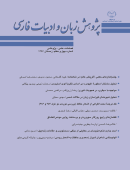احمد جام و تذکرهنویسان در حکایتی از جنگی دستنویس و «مقامات ژندهپیل»
محورهای موضوعی : پژوهشهای ادبیات کلاسیک ایران
1 - دانشگاه پیام نور
کلید واژه: احمد جام تذکرهنویسی طغرل تکین سلطان سنجر نسخة خطی,
چکیده مقاله :
تحلیل بازنویسی متون ادبی در دورههای مختلف تاریخی با توجه به تغییرات زبانی، در حوزة واژگان، نحو و بلاغت میتواند دگرگونی مفاهیم و تصاویر مندرج در آن آثار و تأثیر تغییرات تاریخی بر متون را نشان دهد. تذکرهها و تراجم احوال نیز از این قاعده خارج نیستند و شاید بتوان گفت که در هر دوره از بازنویسی متون ادبی تصویری جدید از متون پیشین خلق میشود. درکتاب «مقامات ژندهپیل» حکایتی از احمد جام نقل است که از قضا در یکی از نسخههای خطی دانشگاه تهران که به صورت جُنگ ثبت شده، روایتی به لحنی دیگر از آن آمده است. این پژوهش علاوه بر ذکر و تصحیح این چند برگ به دنبال آن است که چه اندازه تذکرهنویسان و حکایتپردازان به اشارههای آهسته قلم در توصیف ویژگیها و شیوة سلوک شیخ جام تغییر داده و با جملهای و خطی، تصویری مبهم از او نشان دادهاند. در این دو نسخه، علاوه بر اختلافات زبانی و بلاغی تغییراتی در مکانها، چگونگی وقوع رخدادها و واکنشها دیده میشود که پایبند نبودن تذکرهنویس به متن اساس و اولیهای را نشان میدهد. اما شباهتهای بسیار در جملهنویسی و بیان موضوع میان دو نسخه، نشان دهنده وجود نسخه اصیلتری از داستان است که منبع هر دو روایت محسوب میشود. در شیوه بلاغی و چگونگی بیان، از نظر نحو و الگوهای زبانی میان دو روایت تفاوتهایی وجود دارد. از نظر محتوایی نکته قابل توجه این است که نویسنده هر دو مکتوب به بیان اطلاعات دقیق و مشترک تاریخی و جغرافیایی از موضوع میپردازند و در ارائه آمار اختلافی ندارند از طرفی تمام این حکایت خود سند روشنی است از جایگاه و قدرت صوفیه در دورههای تاریخی مورد نظر.
Changes in linguistic potentials and the expansion of vocabulary storage, and the development of syntetic and rhetoric patterns in different periods of time may result in different readings and recreation of the texts. Tadhkirah (memorandum) and biographies are no exceptions. Infact, each revision of literary texts creates a new picture of the previous text. In order to find the facts in the texts with real and historical basis, especially in the history of literature, comparing writings in different periods of time and the differences between narratives according to linguistic features and intellectual features of that period is very important. It shows the difference in people’s thoughts in each period and the effect of external factors on the creation of the literary works. In " Maqamat-e Zhandeh Pil" there is a narration about Ahmad-e Jam which is narrated in one of the manuscripts of Tehran University too, but in a different way. In addition to correcting this manuscript, this research aims at finding those instances that show how narrators and those who write memorandums with some subtle changes in describing his characteristics and manners through a sentence or just a word demonstrate an obscure picture of Sheikh-e Jam. Comparing these two narratives show that in addition to some linguistic and rhetoric differences, there are some changes in the setting, and description of the events and actions which indicate that the narrators have not been that loyal to the original text. However, their similarity in sentencing and narration indicates the existence of an alder narration of the story which has probably been the source of both these manuscripts. Considering contents, both writers explicitly illustrate the same historical and geographical information about the subject with no discordance. Furthermore, this story is a clear document indicating the power and state of Suffiya in that era.
برجساز، غفار، خلیلاللهی، شهلا (1394) «نظریه مبتنی بر واکنش خواننده در تذکرهنویسی» مجموعه مقالات هشتمین همایش پژوهشهاي زبان و ادبیات فارسی بهمن 1394 با همکاری پژوهشگاه علوم انسانی.
برسلر، چارلز (1386) درآمدي بر نظریهها و روشهاي نقد ادبی، ترجمة مصطفی عابدینیفرد، تهران، نیلوفر.
پاینده، حسین (1385) نقدادبی و دموکراسی، تهران، نیلوفر.
جام، نامقي، احمد (1368) انس التائبين و صراط الله المبين، با مقدمه، تصحيح و تعليقات علی فاضل، ------------- (1372) روضه المذنبين، با مقدمه، تصحيح و تعليقات علي فاضل، تهران، مؤسسة مطالعات و تحقيقات فرهنگي علي فاضل، تهران، توس.
------------- (1378) کنوز الحکمه، به تصحیح علی فاضل، تهران، پژوهشگاه علوم انسانی و مطالعات فرهنگی.
روحانی، مسعود، قنبری کناری، فاطمه (1391) «مقایسه شخصیت ضحاک در شاهنامه، مینوی خرد و روایت پهلوی از حیث کارکرد اسطورهای حماسی»، مجله مطالعات ایرانی سال یازدهم، شماره بیست و یکم بهار.
زرینکوب، عبدالحسین (1369) جستوجو در تصوف ايران، تهران، اميركبير.
----------------- (1383) «تصوف و عرفان در اسلام» مجموعه مقالات پژوهشي تاريخي و فرهنگي، زير نظر كاظم موسوي بجنوردی، تهران، وزارت فرهنگ و ارشاد اسلامي.
----------------- (1385) ارزش ميراث صوفيه، چاپ دوازدهم، تهران، اميركبير.
شفیعیکدکنی، محمدرضا (1393) درویش ستیهنده، تهران، سخن.
شفيعيون، سعيد (1393) «گذري ديگرگون بر تذكرههاي ادبي»، مجله فنون ادبي دانشگاه اصفهان سال ششم، شماره 2 پياپي11.
صفا، ذبیح الله (1387) تاریخ ادبیات ایران، تهران، فردوس.
غزنوی، سديدالدين محمد (1340) مقامات ژندهپيل، به اهتمام حشمت مؤيد، تهران، بنگاه ترجمه و نشر كتاب.
غنی، قاسم (1389) تاریخ تصوف در اسلام، تهران، زوار.
فاضل، علی (1373) شرح احوال و نقد و تحليل آثار احمد جام، تهران، توس.
-------- (1383) كارنامه احمد جام، تهران، توس.
لمبتن آن کاترین سواین فورد (1382) تداوم و تحول در تاريخ ميانه ايران، ترجمه يعقوب آژند، تهران، ني.
هاشمی سندپلوی، احمد (1970م) مجمع الغرایب، به اهتمام محمد باقر ج اول، لاهور.

